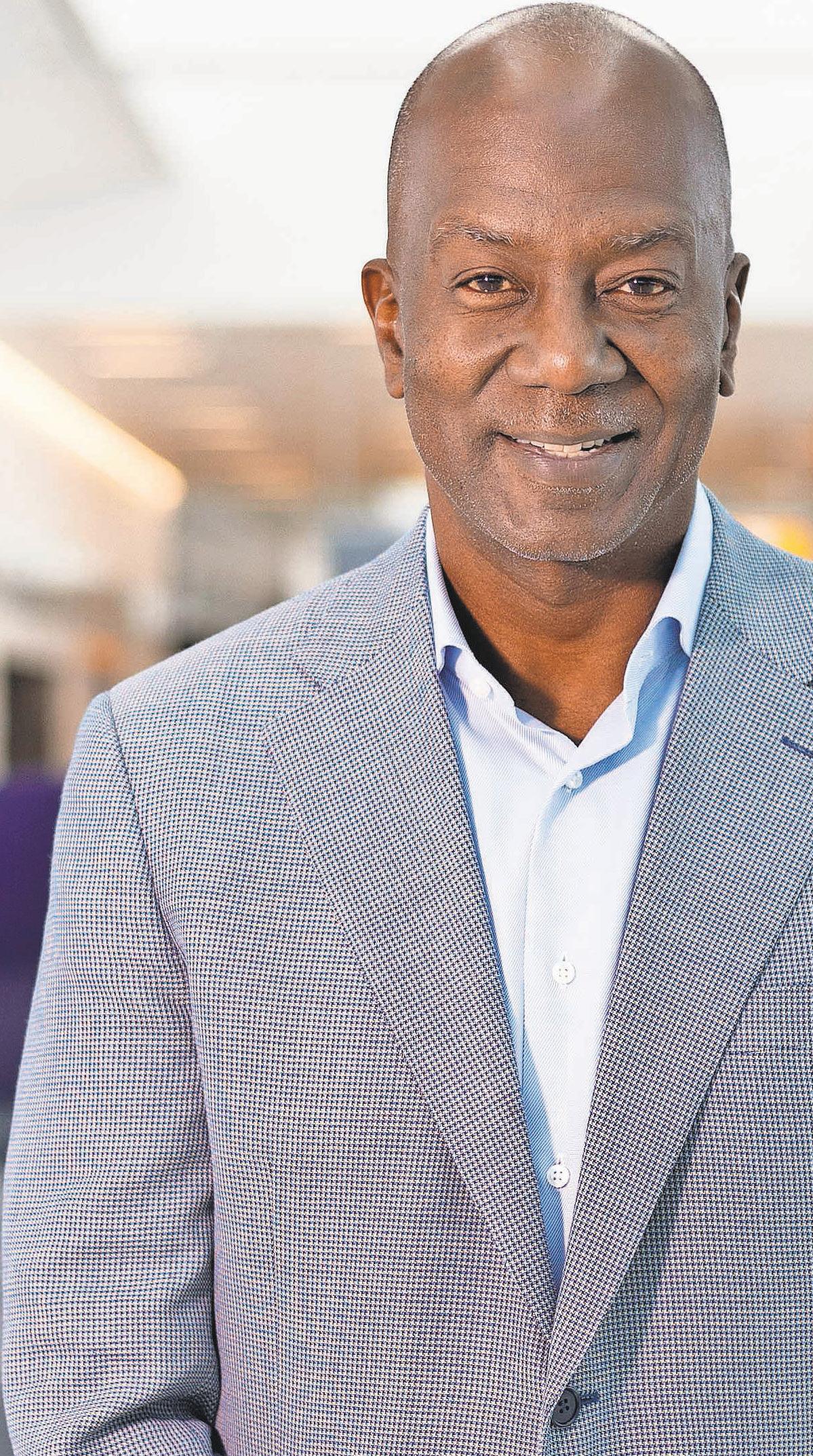


















Last week the nation experienced yet another mass shooting. Tis time, it happened on the Michigan State University campus in East Lansing. The gunman killed three and wounded five others. The extra ammunition and “kill list” authorities said he possessed suggest the situation could have been even worse. By now, you’ve heard the fact that the US has experienced more mass shootings this year than number of days. Folk who want to see change have to recognize the choice before us. It’s “Te Ballot of the Bullet” (to borrow the title of a Malcolm X speech). We know the gun lobby is the pimp and the GOP lawmakers who block gun reform are gunmakers’ “hoes.”

We also know that over 75% of Americans (Republican and Democrat) want gun reform. In recent years, 60% of voters vote during presidential elections with other elections seeing a 40% voter turnout. Tat means literally millions of folk aren’t voting. But we don’t even need millions; just a few thousand more votes nationally could swing power away from “thoughts and prayers” advocates and give it to those who are tired of seeing masses of people gunned down.
A US congresswoman, who I hate to even name, Marjorie Taylor Green, is openly calling for “red” states to separate from “blue” ones—an act in total opposition to the Constitution she took an oath to protect. Te US Speaker of the House, Kevin McCarthy, handed over all Jan. 6 US Capitol insurrection security footage to Fox News host and white nationalist favorite Tucker Carlson. An act so blatantly unfair and unethical it’s too obvious to even explain. Several GOP lawmakers slammed President Joe Biden for
visiting Ukraine, saying “Ukraine ain’t our friend and Russia ain’t our enemy;” words consistent with the political party that was cool with their president (Tefon Don) colluding with and being in debt to Russia to the tune of multiple millions. Te party of supposed “law& order” and “family values” celebrated insurrectionists, “cleared” a child trafcking colleague (Matt Gaetz) and “forgave” a state AG (Texas) who has committed more crimes than Trump has lies. And these scoundrels have the nerve to tell us what is lawful, Christian and just, while acting in anti-law, anti-Christian and anti-justice ways. Te show “Stranger Tings” has a “real” world and an alternate universe called “Te Upside-Down.” But what do we call our “real” world when lawless lawmakers defne their evil as “good” and lawlessness the “law of the land”?
One important aspect of “history” is the lessons we can learn from it. To that point, let’s listen to the epitome of Black Resistance, Harriet Tubman, who shared these words while freeing her enslaved sisters and brothers—advice we’d do well to heed today: “If you hear the dogs, keep going. If you see the torches in the woods, keep going. If there’s shouting afer you, keep going. Don’t ever stop. Keep going. If you want a taste of freedom, keep going.” Black people… keep going!
ON THE WEB
• Meet the co-founders of Houston’s Hip-Hop Museum.
• See why Blacks & Latinos in Texas say “Don’t drink the water.”
• Check out the top Black Power songs of all time.
A new law will provide millions of dollars to train Houston police ofcers in de-escalation tactics. Te bill was frst introduced by Senator John Cornyn afer the death of George Floyd prompted global cries to end police brutality.
Te new law, which was signed on Dec. 27, 2022, authorizes $124 million in grant funding over 4 years for police training in de-escalation tactics, especially when dealing with people sufering from mental health crises. Te goal is to reduce the number of ofcer-involved deaths and retain experienced police.
Mayor Sylvester Turner said the federal funding would be “a tremendous beneft” to the city of Houston.
“Tis is a large city, 640 square miles, and things are happening throughout the city, sometimes at the same time. Any additional dollars that can help us increase the number of support, increase the number of teams, especially for people in crisis will help out quite a bit,” Turner said.
Te training’s curriculum — which is currently being developed by the U.S. Department of Justice, will be made available to state and local law enforcement agencies.
Afer the death of George Floyd in 2020, Mayor Turner met with U.S. Sen. John Cornyn and Houston-area leaders to discuss the relationship between law enforcement agencies and community members. According to Cornyn, input from that discussion was incorporated into the law.

“Tis is a tough job and recruiting is not easy because it can be a dangerous job,” Cornyn said. “And we want to keep our law enforcement ofcials who are on the job now. We want to keep them as long as we can. Tis de-escalation training act will supplement the good work being done here at the local level and hopefully, in the end, save lives and get people the help they need,” Cornyn said.
Te Texas NAACP urges all citizens of goodwill to join them and their partners in fghting to stop the state of Texas from continuing what the iconic civil rights organization is calling “its move back to Jim Crow.”
“We do not say this as hyperbole to make a point, but because it is real as we continue to see new laws and initiatives that are aimed at advancing white supremacy,” said NAACP Texas President Gary Bledsoe. “Te new initiative by our Governor to seek the elimination of Diversity, Equity and Inclusion (DEI) programs from state government is just such an initiative.”


Bledsoe invoked Dr. Martin Luther King Jr., noting that he once said he was aware that we could not pass laws to make people love each other, but that we could pass laws that prohibit people from acting on the most evil and extreme thoughts as seen in [Abbott’s] initiative.
Bledsoe and the state’s NAACP is calling on individuals and organizations to join with them and their Texas Legislative Black Caucus partners to:
• Request the NBA, NFL, Major League Baseball and NCAA cease to use Texas as a designation for their major sporting events (All-Star games, Super Bowls, tournament games, etc.) until Abbott withdraws his current action;
• Reach out to Corporate America for their support in persuading Governor Abbott to reverse his course of action; and for these companies to speak the truth about DEI policies and their impact so the public gets the facts; and
• Call on all Texans, regardless of political party, to press Abbott to keep DEI policies in place
Te NAACP shared the following bullet points for Texans to understand what’s at stake with Abbott’s DEI changes.
• The US Dept. of Education Office of Civil Rights issued a fact sheet (memo) last week discussing DEI Programs and making it clear that such programs are generally legal programs designed and intended to combat discrimination instead of causing it;.
• DEI programs are designed and intended to counter historical and current
discrimination practices and policies that have prevented people of color from getting job opportunities or admission to state colleges and universities; to help open doors as DEI policies are goals and objectives that aren’t backed by law;
• African-Americans, Hispanic Americans and Asian Americans are all tax-paying Texans, fnancing state government and its services. And as such, they deserve to be represented and hired into the job force at all levels. Looking at current numbers, these groups are signifcantly underrepresented across felds in employment and in the state’s public colleges and universities.
• Eliminating DEI will send a message that it’s OK to take away a key tool that is helping facilitate equity and fairness in the workplace and in higher education institutions. Tat message no doubt would discourage businesses and corporations from locating in Texas.
For more information visit www. txstatenaacp.org or contact Gary Bledsoe at 512-322-9992 or gbledsoe@thebledsoelawfrm.com.
A bill was fled in the Texas Legislature that would prohibit polling locations on college campuses throughout the state. State Rep. Carrie Isaac (R) of Wimberley fled House Bill 2390, one of over 100 election-related bills that have been fled this session. Voting rights advocates say the bill is a targeted attack on the political power of young voters.
Isaac represents Comal County and parts of Hays County, which fipped Democratic during the 2018 U.S. Senate race. Te county later favored Democrats Joe Biden and Beto O’Rourke by over 10 points in the 2020 presidential election and 2022 governor’s race, respectively.
Alex Birnel, Advocacy Director for MOVE Texas, a nonpartisan nonproft focused on increasing voter engagement, credits the fip to the large number of young voters at Texas State University, located in Hays County. In 2018, Texas State’s early voting location closed afer the frst 3 days of the early voting period, during which students faced hour-and-ahalf-long waits to cast a ballot. Te location reopened afer the Texas Civil Rights Project threatened Hays County with a lawsuit unless it allowed Texas State’s on-campus polling station to remain open for the duration of the early voting period and expanded the location’s hours to 7 a.m. to 7 p.m.
Birnel said House Bill 2390 has no clear purpose other than to decrease young voter turnout.
“Te bill text is so short that it doesn’t illuminate any
further why this bill would be fled other than to directly target places where universities have large enough voting populations to fip the county, like we saw in Hays County back in 2018,” he said.

Rep. Isaac has not responded to requests for comment regarding the bill.
In the last 10 years, Texas has closed a total of 750 polling locations — the most of any state — in favor of fewer centralized voting locations in order to cut costs, according to the Leadership Conference of Civil and Human Rights. Tis came afer the Supreme Court’s ruling in Shelby County v. Holder in 2013, which eliminated pre-clearance from the Voting Rights Act of 1965. “Pre-clearance” required jurisdictions with a history of racially discriminatory election procedures to get federal approval of any proposed changes to election practices. With the provision’s repeal, states can now implement new voting laws and procedures — such as polling location closures — without oversight from the Department of Justice’s Civil Rights Division.
Many worry the closure of polling facilities with disproportionately disenfranchise people of color. One 2020 study from the American Economic Association found that a onemile increase in distance to a polling location reduced voter turnout from districts with minority residents by 19%. Meanwhile, for predominantly white communities, voter turnout decreased by only 5%.
The Houston NAACP recently hosted their annual Freedom Fund Gala with the theme, “Freedom Forward... Ensuring Justice and Equity for Future Generations.” This event not only recognizes those who have stepped up and fought for social justice but this event serves as an annual fundraiser to help support all branch advocacy eforts that beneft thousands of Houstonians annually. The Mickey Leland Humanitarian Award was presented to State Rep. Senfronia Thompson for her many years of service and leadership.

Exxon Mobil, Lyondell Basell and Tricon each presented the checks at Lantrip Elementary School this month to solidify its partnership for the pilot Zero-Waste Project.

Te program will utilize a reduce, reuse and recycle sustainability plan focusing on material recycling, composting and waste management comprising 20 campuses from administration buildings to high schools in the district.
HISD will implement the program starting in April. Te recycling project will be placed on campuses to make it easier for students and staf to understand the diference in each material that is being collected.
“As a company we are committed to sustainability especially with regard to better use of plastic waste instead of going to a landfll or being incinerated. We want to start here in Houston where we have large facilities in Baytown where we can recycle plastics,” said Loic Vivier, senior vice president Exxon Mobile specialty products. “Te key is to address two signifcant hurdles. One is access, to have the infrastructure and logistics and the second is to educate our community of the necessity and how this benefts the environment and community overall.”
A team of Rice University undergraduate students will also be helping HISD in sustainability research and policy for its new program. Te frst phase of the research will focus on engaging with literature, case studies and informational interviews to gauge how HISD can move toward zero waste.
Te second phase will allow a continuation of consultants’ fndings on curriculum, logistics and operations, and economic value and sustainability.
VOLUME 92, NUMBER 15 - FEBRUARY 23, 2023
Publisher | CEO
Sonceria Messiah-Jiles
Strategic Alllance Clyde Jiles
Digital Content Manager Michael Grant
Managing Editor
ReShonda Tate
Associate Editor
Aswad Walker
Education Reporter
Laura Onyeneho
Sports Terrance Harris
Jodie B. Jiles
Photographer
Jimmie Aggison
Social Media Manager
Tia Alphonse
Intern
Alania Bookman
The Defender newspaper is published by the Houston Defender Newspaper Inc. and audited by Alliance for Audited Media (AAM). Only digital subscriptions are available at: www.defendernetwork.com/subscribe
No materials herein may
reproduced without the written permission of the Publisher. 713-663-6996 | P.O. Box 8005, Houston, TX 77288





Real infuencers stay connected to their followers using ultra-fast WiFi. They stream, game, and create content for their online fanbases. With Xfnity supersonic WiFi, there's space to power every device in your home. Now, everyone can stay one step ahead of the game anytime, anywhere.







It is impossible to do justice to Black people’s history of resistance from oppression, brutality and white domestic terrorism in just this country alone, much less our global history of resistance. It’s equally impossible to find large contingents of Blacks who know about our incredible legacy of resistance.
Why? Because Black people’s history of
standing up, speaking out and fghting back against oppressive forces was viewed as dangerous to the status quo, in that such knowledge might inspire even more resistance and a changing of this nation’s power dynamic. Tus, our legacy of resistance was ignored, replaced by false narratives of the happy enslaved person who was some combination of docile, cowardly and complacent.
The truth, however, paints an entirely diferent picture.
During our enslavement in America, resistance took many forms, including the work of abolitionists like Frederick Douglass and Sojourner Truth, but also the freedom “by any means necessary” writings of David Walker and others.
Moreover, the enslaved resisted in other ways, including work slowdowns, the purposeful breaking of tools, grinding up glass and serving it in “massa’s” food, eventually
killing him. Moreover, escaping bondage was a constant way we resisted. And though we are taught extremely little about enslaved uprisings, most are familiar with those movements led by Gabriel Prosser, Denmark Vesey and Nat Turner. Some may even have heard of Bacon’s Rebellion where enslaved Blacks and dirtpoor whites fought together against wealthy, land-owning whites—until those landowners bestowed the “idea of whiteness” and
white privilege upon the poor whites, who then sided with the wealthy. But few know the name of the largest enslaved rebellion in US history. Andry’s Rebellion, also known as the German Coast Uprising, was a revolt that took place in Louisiana from Jan. 8 – 10, 1811. Fewer still know of the “Maroons,” a name given to enslaved Africans who fought for their freedom or escaped and formed entire free communities in the swamps and forests of
every nation where slavery existed. In the US, Maroon communities could be found in Georgia, the Carolina, Louisiana and especially Florida, where many Maroons joined with the Seminole nation and fought successfully with them against American troops and “slave” patrols.
And though rarely mentioned, uprisings took place locally, according to University of Houston history professor, Dr. Gerald Horne.
“I would say that during that period (enslavement), not only in Houston, but in Texas generally, there were numerous uprisings,” said Horne.
JUNETEENTH
But Horne goes further, arguing that General Granger’s famous proclamation read on June 19, 1865 was by no means the culmination of the Juneteenth story. In his latest book, “Te Counter-Revolution of 1836: Texas slavery & Jim Crow and the roots of American Fascism,” Horne shows that though Confederate troops surrendered in April 1865, they planned to continue the war using Mexico as their base of operations in coalition with the French. However, Granger and his thousands of predominantly African (Black) troops, afer fghting valiantly and victoriously to free enslaved Blacks in Texas, then saved America from these ongoing Confederate plans.
“It’s not only June 19, 1865, that we should mark, but also June 19, 1867, because that’s when the French leader Maximillian was killed, which marks the end of the attempt to continue our enslavement in Mexico,” said Horne.

Contrary to popular belief, 100 years before the Voting Rights Act 1965, the Voting Rights Act of 1865 gave Black men the right to vote. And we used our vote/voice throughout the entirety of Reconstruction, fghting against mistreatment by electing candidates who looked like us and had our best interests at heart.
Te result: More than 1,500 Black ofceholders served during the Reconstruction era (1865–1877) at the local, state and federal level.
Te end of Reconstruction (1877) brought on a massive wave of white domestic terrorism, with Confederate leaders who were traitors to the US, being given full power to rule their southern states the way they saw ft. Still, we resisted. One way we did so was by building Black towns all across the country.
In the late 1870s, many Blacks headed west where they created all-Black cities like Nicodemus, Kansas. A wave of Blacks settled in Oklahoma, the state with the most Black-founded cities in the nation, including
the Greenwood section of Tulsa, Oklahoma known as “Little Africa” by some and “Black Wall Street” by others.
But no state was “immune” to Black resistance in this form (i.e. Seneca Village, NY and Rosewood, Fl).
We also founded institutions with our best interests at heart as a way of resisting tyranny. Tuskegee Institute (1881), National Business League (1900), Bethune-Cookman (1904), NAACP (1909), National Urban League (1910) and eight of the Divine Nine (1906-1922) are just a few examples. Many of these institutions supported the one-woman “movement” known as Ida B. Wells Barnett, who between 1898 and the 1930s waged war against the lynching of Blacks.
Tough white domestic terrorism aimed at Blacks never ceased, Black resistance increased, especially when Black veterans returned home from WWI.
The 1915 movie “Birth of a Nation” which depicted the Ku Klux Klan as saviors of America, resurrected the KKK and increased lynchings of Blacks. With the war’s end, and soldiers allowed to maintain their military-issued weapons, Blacks across the country fought back.
Te Camp Logan rebellion (1917) serves as a local example of Blacks refusing to allow themselves or their families to be slaughtered without ofering some level of resistance. Tat same year, Black veterans now farmers who sought to unionize, were attacked by whites, and they fought back, though unsuccessfully, as Black men, women and children were massacred. But such battles took place nationally, so much so, that 1919 is forever known as the “Red Summer of 1919” because of all the terrorist attacks by whites and the armed resistance given by Blacks.

The Camp Logan rebellion (1917) serves as a local example of Blacks refusing to allow themselves or their families to be slaughtered without ofering some level of resistance.”February 28: Black Resistance from the Harlem Renaissance to today, including the TSU “Riots,” the TSU Five and UH fght for Black Studies. Camp Logan trial. National Archives and Records Administration
 By ReShonda Tate
By ReShonda Tate
Te national 2023 Black History Month theme, “Black Resistance,” explores how African Americans have addressed historic and ongoing disadvantages and oppression. We’ve had no shortage of tragic stories – from Tyree Nichols to George Floyd to Emmitt Till. All too ofen, those stories depict only our hardest times, erasing the wholeness of who we are. Yes, struggle and resistance are part of our stories. But so is hard-won happiness, success and joy.
As we are inundated daily with images of trauma, it’s important to remember that joy can help us heal, too. In fact, the act of joy is resistance and just as we use our physical bodies to protest, march and demand change, we must also use them to experience the pleasure of joy.
Kleaver Cruz of the “Black Joy Project” is just one of many who have been encouraging Black people to choose joy as a form of resistance. He defnes Black joy as “internally driven” happiness that can happen when someone consciously chooses pleasure as a way to combat the traumas of racism.

“When we acknowledge that we exist in an anti-Black world that is set up to ensure we do not live, to choose life and to choose to enjoy any aspect of that life is a radical act,” Cruz said. “Amplifying Black joy is not about dismissing or creating an ‘alternative’ Black narrative that ignores the realities of our collective pain. Rather, it is about holding the pain and injustices we experience as Black folks around the world in tension with the joy we experience in pain’s midst. It’s about using that joy as an entry into understanding the oppressive forces we navigate through as a means to imagine and create a
world free of them.”
Troughout Black history, joy for African Americans has been grounded in freedom and self-determination, says Rhode Island College Africana Studies Program Director Sadhana Bery, who has even started a collegiate course titled “Black joy.”
“I would hear Black students in my classes express their weariness and despair because ofen the focus of Africana studies courses is on anti-Blackness and the structures of white supremacy in our society. Tey felt depleted when they considered the history and contemporary existence of Black people,” says Bery. “Tey lived through the Black Lives Matter movement and saw that
even the largest Black social movement, which became a global movement, had not led to comprehensive racial justice. So I asked myself, ‘Where is the Black joy in these courses? Why don’t we ever focus on that?
“Freedom, self-determination and sovereignty have always been tied into the idea of Black joy,” she says. “During slavery, Black people fed to freedom and created their own maroon communities. During Jim Crow, many more lef the South and created their own Black towns in Kansas, Oklahoma and the Midwest. During the 60s, groups such as the Black Muslims also formed communities.
“Black Joy is created in everyday life – in gatherings, storytelling, family cooking traditions, gardening, music, self-care . . . in a plethora of spaces,” she says.
“In fact, Black joy itself is a form of resistance to anti-Blackness,” says Bery. “It’s a refusal to let racism dictate your life.”
We ofen hear how getting therapy, adequate sleep, and practicing self-care can help your mental health, but Cruz says choosing joy is just as important to get your mental health back on track.
“I think one of the most radical things you have access to is imagination. We literally have the ability to create what does not yet exist that we need,” he said. “And Black joy, choosing it as a way to practice that imagination, to make it real. And deciding like, this is what I need.”
Blackness is an immense and defant joy.”
Tracey Michae’l Lewis-Giggetts author of “Black Joy: Stories of Resistance, Resilience, and Restoration”Readers share what brings them joy. DN ONLINE Movies that capture Black joy. DN ONLINE





Texas Southern University began playing intercollegiate baseball nearly 60 years ago. The Tigers have yet to play a game on their home campus, but that will soon change thanks to some significant support from the most prominent team in town.
Texas Southern, a historically Black university in Houston’s Third Ward, received a $1 million donation from the Astros Foundation over the weekend so it can construct on-campus baseball and softball stadiums. The college teams currently play their home games at city parks – the baseball team at MacGregor Park and the softball team at Memorial Park.
“It’s a game-changer for us,” said Kevin Granger, Texas Southern’s vice president of intercollegiate athletics. “It’s huge for us to have an organization like the Astros behind us and assisting us with getting these well-deserved facilities for the student-athletes.”
Texas Southern is expected to break ground and start construction on the stadiums later this year, according to Granger, who said it’s yet to be determined whether the facilities will be ready in time for the Tigers’ 2024 seasons. The school’s baseball and softball teams, which compete in the Southwestern Athletic Conference, started their 2023 campaigns earlier this month.
Texas Southern’s baseball team opened the season last week at the inaugural Cactus Jack HBCU Classic, which the Astros hosted at Minute Maid Park through a partnership with Houston-area rapper Travis Scott and his Cactus Jack Foundation. The university was presented with a ceremonial check for $1 million during the round-robin weekend

tournament, which also included fellow HBCUs Prairie View A&M, Grambling State, Jackson State, Mississippi Valley State and Southern.
The forthcoming stadiums will be made available to the surrounding community when the Tigers are not using them for practices or games, Granger said.
“If you look around the Third Ward area, there’s not a whole lot of community facilities for the community to practice or learn the game,” he said.


Granger said the donation from the Astros organization was about two years in the making, because that’s how long ago he met franchise owner Jim Crane and discussed the school’s athletic needs. Granger said he had taken the Texas Southern golf team to Memorial Park Golf Course in conjunction with Houston Open, the annual PGA Tour event hosted by the Astros Golf Foundation, and Crane pledged to help the university with its baseball and softball facilities.

Their encounter also helped spawn an ongoing partnership between the Astros and the university at large, Granger said. Texas Southern students interned last year with the Astros, who also are providing scholarships for the school’s sports management program, according to Granger.
“TSU students deserve the opportunity to go from playing and watching baseball at a city park to having their own stadium on campus,” Paula Harris, the director of the Astros Foundation, said in a news release from the team. “The entire World Series-winning Astros organization is proud to be a part of the historic and monumental opportunity for Texas Southern University baseball.”
Texas Southern freshman guard Kolby Granger was named the SWAC Impact Player of the Week after scoring a career-high 29 points in a win over Southern.

The University of Houston Cougars basketball team is back at No.1 in the AP Polls for the third time this season
The Cougars moved up one spot this week after defeating Memphis and after previous No.1 Alabama relinquished the No.1 spot following its loss to Tennessee.
The USFL has announced NFL veteran offensive assistant coach and former Tulane head coach Curtis Johnson has been hired as the new coach of the Houston Gamblers. Johnson immediately assumes duties from Kevin Sumlin. Last week, Sumlin accepted the offensive coordinator position at University of Maryland.

Following a two-year hiatus, the Houston Roughnecks made a triumphant return to XFL action last weekend when they defeated the Orlando Guardians, 33-12, during the season opener at TDECU Stadium. The Roughnecks came up with seven sacks on former Denver Broncos quarterback Paxton Lynch and went on to score 24 unanswered points to give Wade Phillips a win in his debut as the head coach.


Texas Southern senior forward John Walker III has been tabbed SWAC Impact Player of the Week. Prairie View senior guard Will Douglas has been named SWAC Player of the Week.
Roughnecks wide receiver Deontay Burnett caught eight passes for 90 yards, which included a 46-yard touchdown during the season-opening win.

When it comes to the legacy Robert Moreland has created, Texas Southern athletic director Kevin Granger says it best.
“You can’t say TSU Basketball without recognizing all the efforts of Coach Moreland,” said Granger, who starred for Moreland at TSU from 1992-96. “He brought that winning mentality to the program and consistently preached that hard work and dedication would pay off.”
Moreland’s message applied to his own career, and certainly to the Tigers program as both ascended to incredible heights during his initial tenure from 1975-2001.
The Utica, Mississippi native found his way to TSU as a result of a chance meeting with athletic director Rod Paige years earlier. And with Moreland came a Mississippi pipeline of players that elevated the program, starting with Alonzo Bradley and Marcello Singleton in 1975 and continuing with Granger nearly two decades later.
It wasn’t long before the Tigers would become something of a powerhouse with Moreland in charge, winning the NAIA National Championship in 1977 followed by SWAC Tournament titles and NCAA Tournament appearances in 1990, 1994 and 1995. Indeed, the man who became known as “Top Kat” had the Tigers rolling for much of his 27-year tenure. Moreland, who is now 84, guided TSU to six 20-win seasons, one 30-win season, five SWAC conference championships, two SWAC co-championships and three conference tournament championships.
Moreland and his aggressive brand of basketball produced three national scoring champions and All-Americans in Harry “Machine Gun” Kelly (twice) and Granger.
Players such as Ron Cavenall, Larry Williams, Bradley and Kelly all spent time in the NBA following their college careers under Moreland.
For his efforts, Moreland was a five-time SWAC Coach of the Year, American Wire Service 1994 National Coach of the Year and the American Wire Service National Black College Champion in 1994 and 1995.


Moreland, who would later serve as interim coach of the Tigers during the 2007-08 season, finished as the Tigers’ all-time leader in wins with 406 victories to his credit.


But not only was Moreland a great basketball coach, he was an even greater builder of great men.
Dr. Lacey Reynolds, who played for Moreland at Utica College and later coached under him at TSU, points to Granger and others as examples of the high-quality and successful men he produced.
“I just think Coach Moreland was a builder of men,” Reynolds said. “He never received the credit for the type of men he produced. Not only did he produce great
basketball teams, but he produced great family men, great leaders in our community. He instilled in us the will to reach back.”
In 2007, Moreland was inducted into the SWAC Hall of Fame and TSU renamed its basketball court at H&PE Arena in Moreland’s honor.
“Coach Moreland was a leader, a father figure. He definitely knew the X’s and O’s and he was very strategic as a coach,” Reynolds said. “He was one who was very balanced as a good teacher and coach.”





 By Jimmie Aggison
By Jimmie Aggison

Imagine growing up in a community, playing on the varsity basketball team at the local high school, going to college on a full-ride athletic scholarship, then having the opportunity to come back to that same community that helped raise you, to instill some of those positive values you learned on the way in the younger generation in students who now walk the same halls you once did.
In the words of the Notorious B.I.G. “It was all a dream.” But for Willowridge girls’ basketball coach Tiffany Collins, it’s no longer a dream, it’s a living reality.

With the Willowridge High School girls’ varsity basketball program not being the basketball powerhouse it once was, coaching at Willowridge is more than just about basketball for Coach Collins.





“I try to teach my players resiliency, and try to show them that there is something else outside of this community,” said Coach Collins. “While we have you, we want you to be the best person you can be and we want to teach you the skill set that you need to be a good citizen once you leave high school.”
Regarding resiliency, Collins and her players had to show plenty during her team’s tough times.
In 2017 the school was faced with a mold problem that forced students to attend classes at Marshall High School. This presented a different set of issues as players who needed tutorials would miss all of practice because the buses were only scheduled for certain times. Once this problem was resolved, COVID hit, and many school systems across the nation shut down.






“Nobody really wanted to get involved with sports or socializing,” Collins says.
However, this didn’t stop Collins from teaching her team about resilience; getting through the tough times.
“Last year I was blessed with a good group of freshmen who you could see the skill set coming. We just needed a little
more repetition, a little more time on the court. We needed to get stronger and more physical,” shared Collins.
Last season, Willowridge went 2-13, finishing at the bottom of its division. After another losing season, Collins said her players went to work.

“We probably played a basketball game every weekend. We were in the weight room every day. We were competing with boys in the weight room and on the track. This group really bought into what we were selling.”
Although they were a young team, the buy-in was real. The team went from eighth in the district the prior season, to third in the district with playoff intentions in the 2022-2023 season.
Led by two sophomores and a freshman in their starting five, Collins names Au’Rayona Seals, Natalie Greene and Madisen Moten as pivotal players as they made their playoff run.
Although the team fell short in the second round of playoffs, their youth will allow them to have many returning players continue competing as a unit next season. When asked about her team Coach Collins simply said, “I’m blessed to have this group.”

HBCU grad and California native Phil Grifth is the vice president of United Airlines’ Houston hub at George Bush Intercontinental Airport (IAH) which serves the nation’s fourth largest city and ofers the airline’s customers a key gateway to Latin America.

Grifth’s professional career before landing at United spans across multiple industries, ofcial job titles and continents. But whether managing supply chain operations, coordinating resource deployment strategies or overseeing a company’s global operations, Griffith, has remained firmly grounded, rooted in values and a work ethic that has facilitated his career’s onward and upward trajectory.
Upon meeting Griffith, one is apt to describe him via a phrase coined by the late ESPN sportscaster, Stuart Scott: “He’s as cool as the other side of the pillow.”
But underneath that cool demeanor lies a fery commitment to leadership, service and excellence. Griffith talked with the Defender about his current leadership role at United Airlines and the life experiences that brought him to this moment.
DEFENDER: As VP of United Houston Hub,canyou breakdown what that looks like in terms ofyour day-to-dayresponsibilities?
PHIL GRIFFITH: Our primary responsibility here is to safely support customers in getting from out of Houston to wherever they want to go in the world. And, of course, as they arrive into Houston, getting them with their bags and to de-plane on time, again, in a safe way, so that they can enjoy their time here in the Houston area. Along the way, there are so many other things to it. You’ve got federal regulations with the FAA and air trafc control that coordinate how aircraf fy into and out of George Bush Intercontinental. You’ve got interactions with service providers, like
wheelchair pushers or cabin cleaners or people who do catering or that service the aircraf from a fuel standpoint. Of course, we have our own United employees that really are the face of the company when it comes to ticketing and boarding customers onto the aircraf.
And we want to do that in a way that is a pleasant experience. One where customers feel as if their trip really starts at the airport, or their vacation starts at the airport, and that we’re a constructive part of their journey. We’ve got tech ops that is responsible for maintaining the aircraf. Again, safety is a top priority, and aircraf require quite a bit of maintenance, be it scheduled maintenance or maintenance that comes about as a result of an event like hail damage, for example. And when you wrap all that up, you know, I’ve lef out the fight attendants, I’ve lef out the pilots, but coordinating with those groups to ensure that we’ve got crews that are available and that have service time available to fy; all of those things comprise the whole process of keeping the airport working functionally, keeping it working on time and keeping it working with, again, the service and the pleasant atmosphere that we’re looking for.
DEFENDER: Can you speak to United’s relationship with HISD’sSterlingHighSchoolAviation program?
GRIFFITH: What’s of interest to us is supporting young folks that have a dream of becoming airline pilots or technicians that can do various maintenance-related responsibilities or pretty much anything in the airline industry; giving them exposure to the fact that there is more than being a mechanic or a pilot or a fight attendant, that they can do in the aviation industry. So, as we partner with them, we
• Bachelor’s degree in electronics engineering technology, Grambling State University
• Master’s degree in manufacturing systems, Southern Illinois University
• Past executive connections mentor with the W.P. Carey School of Business at Arizona State University
• Current Aviation Management Department board member at Texas Southern University.
understand that young folks in Houston and HISD have the ability to select what school they want to go to for high school. So, the functional role that we play with Sterling in large part is, we have career fairs. We do quite a bit of mentoring. We bring so many of our diferent employees out to Sterling to show them what their life can be like professionally if they go to a school like Sterling and get of to a fast start and eventually leave high school to get into the aviation industry. So, we try to be that living, walking, breathing example of what a career in aviation could look like across all spectrums, again, from the pilots to the fight attendants, gate agents, and even someone like myself who runs the entire operation.